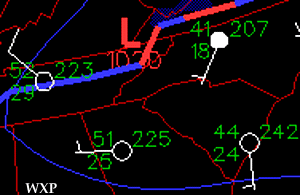|
|
. |
Effects of Moisture
on forecasted precipitation
Even if there is a mechanism to lift the air,
clouds and precipitation
may not occur if the low levels of the atmosphere do not contain
sufficient moisture.
The availability of moisture is revealed on a surface map through the
dew point temperatures.
If the dew point is close to the corresponding
temperature,
the air is nearly saturated, so precipitation is quite
possible.
Consider the example below where a
cold front
was approaching the southeastern United States.
The values of the temperatures
and dew point temperatures
at stations ahead of
the front are close together, meaning the air is nearly saturated.
Since the dew points are quite high, these factors indicate
that there is sufficient moisture for
precipitation to develop,
and the radar echoes
on the map reveal that precipitation occur.
[Image: surface map with reports of high dew point temperatures (33K)]
Now consider a different example with a
stationary
front (depicted on the surface map below).

The values of the temperatures and dew points near the front are
further apart, meaning the air is quite dry. Therefore, despite
the lift provided by the convergence along the front,
there is insufficient moisture for
precipitation to develop.

frontal lifting
|
|

rain or snow
|
|


